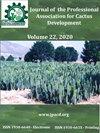墨西哥得克萨斯科科,蚂蚁与多刺的梨仙人掌作物有关
IF 0.4
4区 农林科学
Q4 HORTICULTURE
Journal of the Professional Association for Cactus Development
Pub Date : 2023-01-24
DOI:10.56890/jpacd.v25i.510
引用次数: 0
摘要
在墨西哥,作为多刺梨仙人掌(也称为“仙人掌”)的驯化中心,很少有关于与这种作物相关的昆虫的研究。对蚂蚁的研究很少,因为大多数蚂蚁都不被认为是害虫。出于这一动机,在墨西哥Colegio de Postradados的装置中,对刺梨作物中蚂蚁的种群动态进行了研究。样本于2013年2月至2014年3月每两周进行一次。用陷阱和树上陷阱收集蚂蚁,所有陷阱都有三个诱饵,其他陷阱没有诱饵。还记录了袭击,巢穴在作物和内部的分支。我们总共收集了10953个个体(74%在地面上,26%在刺梨枝序上),并确定了7个物种:不透明低螺旋体(Forel)、黑质内瓦麦粉体(Cresson)、倒钩菌(Smith)、湿线藻(Mayr。后四种更为丰富和频繁。我们讨论了蚂蚁在作物中的存在和筑巢,以及它们与刺梨作物中其他昆虫的关系。本文章由计算机程序翻译,如有差异,请以英文原文为准。
Ants associated to prickly pear cactus crop in Texcoco, State of Mexico
In Mexico, center of domestication of prickly pear cactus species (also called “nopales”) few studies exist on insects associated with this crop. The studies are scantier on ants, since the majority are not considered to be pest. For this motive, the population dynamics of the ants was studied in experimental prickly pear crop in the installation of Colegio de Postgraduados, Mexico. The sample was fortnightly performed from February 2013 to March 2014. Ants were gathered with pitfall traps and arboreal traps, all of them with three baits and others without bait. Also recorded raiding, the nests in crop and inside to the cladodes. We collected a total of 10,953 individuals (74 % on ground and 26% on prickly pear cladodes), and seven species were determined: Hypoponera opacior (Forel), Neivamyrmex nigrescens (Cresson), Pogonomyrmex barbatus (Smith), Linepithema humile (Mayr), Camponotus atriceps (Smith), Pheidole obtusospinosa Forel and Monomorium minimum (Buckley). The last four were more abundant and frequent. We discuss the presence and nesting of ants in crop and their association with other insects of prickly pear crop.
求助全文
通过发布文献求助,成功后即可免费获取论文全文。
去求助
来源期刊

Journal of the Professional Association for Cactus Development
Agricultural and Biological Sciences-Plant Science
CiteScore
1.10
自引率
33.30%
发文量
10
期刊介绍:
The editors of the Journal of the Professional Association for Cactus Development, are very excited to be a part of the excellent editorial committee and to work together to create the synergism between scientists, growers, legislators, and business people so vital to the development of this industry to serve the people of arid lands.
 求助内容:
求助内容: 应助结果提醒方式:
应助结果提醒方式:


